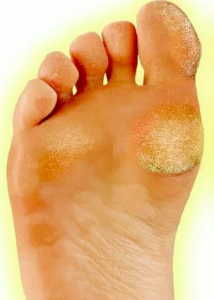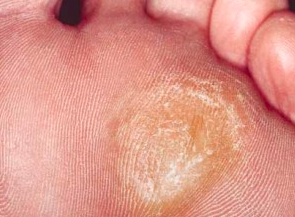 A callus is a hardened and thickened area of dead skin that often develops around the heel, ball of the foot and/or the toes. Callus has a rubbery feel to it and may appear a pale yellow colour, though if the skin is dry, can feel very hard, have a white appearance and may even develop cracks.
Callus can vary greatly in size and may span your entire heel, or just a coin-size patch on the side of your toe. As callus is formed from dead skin cells and areas of callus contain no nerve endings, meaning they have no feeling. Any sensations you experience when touching a callus are from the healthy underlying skin.
A callus is a hardened and thickened area of dead skin that often develops around the heel, ball of the foot and/or the toes. Callus has a rubbery feel to it and may appear a pale yellow colour, though if the skin is dry, can feel very hard, have a white appearance and may even develop cracks.
Callus can vary greatly in size and may span your entire heel, or just a coin-size patch on the side of your toe. As callus is formed from dead skin cells and areas of callus contain no nerve endings, meaning they have no feeling. Any sensations you experience when touching a callus are from the healthy underlying skin.
What causes a callus to develop?
Developing callus is actually a response to either repeated friction and excess pressure. By developing thicker and firmer skin in a high-impact area, your body is protecting itself from further damage like skin breaks which would otherwise leave you vulnerable to infection. Hence, callus often doesn’t cause any problems or pain. Some examples of causes include:
- Poorly fitting footwear that rubs against the skin
- High heels
- Any high-impact activities that load up the feet such as running and jumping
- The way the foot itself functions (that places greater loads through certain areas of the foot)
- Increased weight
- Loss of protective fat pad in the feet
- Dry skin can be a predisposing factor to callus formation
When a callus grows too thick, however, it can put excess pressure on the healthy skin beneath and cause irritation, tenderness and difficulty comfortably wearing shoes.
 How is callus treated?
How is callus treated?
While many won’t need to seek treatment for their callus, treatment is indicated when the skin beneath the callus becomes painful, uncomfortable, or limits your ability to comfortably wear shoes or carry out activities. If you have diabetes or any conditions that impact your ability to feel, it is also very important that you keep your callus well managed as the dead skin means your sensation is diminished further.
As highly-skilled podiatrists, we are able to safely, effectively and painlessly remove the bulk of the callus in the clinic, during your appointment. A small layer should be left intact to continue to protect your skin as per its original intent. Under no circumstances should you try to cut the callus off by yourself using sharp instruments. Improper techniques can damage the healthy surrounding skin, resulting in cuts and infection. If callus is an ongoing issue for your feet, we’ll conduct an assessment to determine the cause(s) of the callus and advise you on how to reduce the onset of callus formation in the future.
 A callus is a hardened and thickened area of dead skin that often develops around the heel, ball of the foot and/or the toes. Callus has a rubbery feel to it and may appear a pale yellow colour, though if the skin is dry, can feel very hard, have a white appearance and may even develop cracks.
Callus can vary greatly in size and may span your entire heel, or just a coin-size patch on the side of your toe. As callus is formed from dead skin cells and areas of callus contain no nerve endings, meaning they have no feeling. Any sensations you experience when touching a callus are from the healthy underlying skin.
A callus is a hardened and thickened area of dead skin that often develops around the heel, ball of the foot and/or the toes. Callus has a rubbery feel to it and may appear a pale yellow colour, though if the skin is dry, can feel very hard, have a white appearance and may even develop cracks.
Callus can vary greatly in size and may span your entire heel, or just a coin-size patch on the side of your toe. As callus is formed from dead skin cells and areas of callus contain no nerve endings, meaning they have no feeling. Any sensations you experience when touching a callus are from the healthy underlying skin.
 How is callus treated?
How is callus treated?







